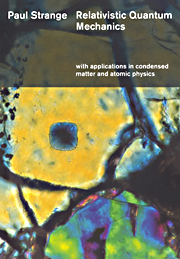Book contents
- Frontmatter
- Contents
- Preface
- 1 The Theory of Special Relativity
- 2 Aspects of Angular Momentum
- 3 Particles of Spin Zero
- 4 The Dirac Equation
- 5 Free Particles/Antiparticles
- 6 Symmetries and Operators
- 7 Separating Particles from Antiparticles
- 8 One-Electron Atoms
- 9 Potential Problems
- 10 More Than One Electron
- 11 Scattering Theory
- 12 Electrons and Photons
- 13 Superconductivity
- Appendix A The Uncertainty Principle
- Appendix B The Confluent Hypergeometric Function
- Appendix C Spherical Harmonics
- Appendix D Unit Systems
- Appendix E Fundamental Constants
- References
- Index
4 - The Dirac Equation
Published online by Cambridge University Press: 11 January 2010
- Frontmatter
- Contents
- Preface
- 1 The Theory of Special Relativity
- 2 Aspects of Angular Momentum
- 3 Particles of Spin Zero
- 4 The Dirac Equation
- 5 Free Particles/Antiparticles
- 6 Symmetries and Operators
- 7 Separating Particles from Antiparticles
- 8 One-Electron Atoms
- 9 Potential Problems
- 10 More Than One Electron
- 11 Scattering Theory
- 12 Electrons and Photons
- 13 Superconductivity
- Appendix A The Uncertainty Principle
- Appendix B The Confluent Hypergeometric Function
- Appendix C Spherical Harmonics
- Appendix D Unit Systems
- Appendix E Fundamental Constants
- References
- Index
Summary
In the previous chapter we discussed the direct relativistic generalization of the Schrödinger theory of quantum mechanics. It was shown that this leads to the Klein—Gordon equation from which some fundamental physics follows. Spin does not appear in either the Schrödinger or the Klein—Gordon theory. Indeed, the Klein—Gordon equation is only appropriate for particles with spin zero. Most of the particles encountered in everyday life (not that one actually encounters many fundamental particles in everyday life) are not spin zero. The most common ones, the neutron, proton and electron, all have spin 1/2. In this chapter we find the equation to describe particles with spin 1/2 and explore its properties. From the title of this chapter you will not be surprised to learn that it is known as the Dirac equation. The Dirac equation is more general than anything that has gone before, and therefore cannot really be derived. Much of the rest of this book involves looking for solutions of the Dirac equation under various circumstances.
Although the Dirac equation cannot really be derived from anything learnt up to the present level, some plausibility arguments for its existence can be given and a couple of these are presented in the first section.
Information
- Type
- Chapter
- Information
- Relativistic Quantum MechanicsWith Applications in Condensed Matter and Atomic Physics, pp. 99 - 129Publisher: Cambridge University PressPrint publication year: 1998
Accessibility standard: Unknown
Why this information is here
This section outlines the accessibility features of this content - including support for screen readers, full keyboard navigation and high-contrast display options. This may not be relevant for you.Accessibility Information
- 1
- Cited by
